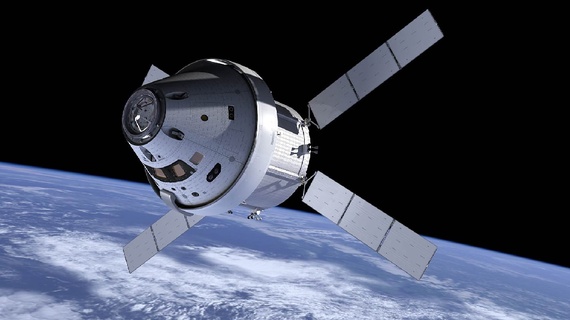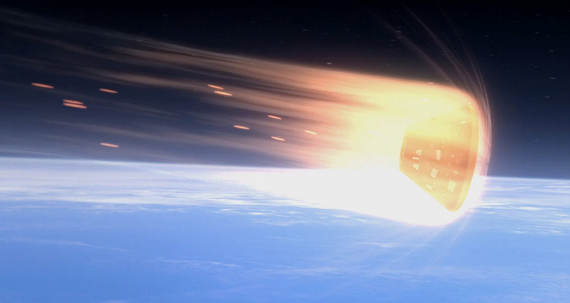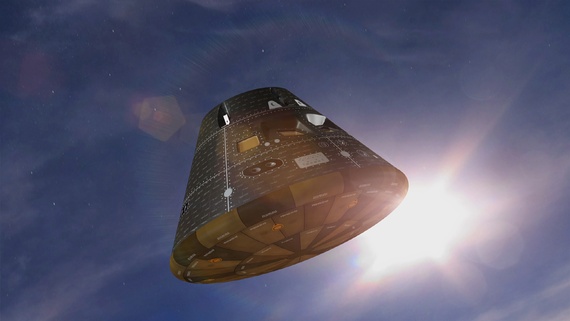NASA: Orion’s Launch is ‘Day One of the Mars Era’

A Delta IV Heavy rocket lifts off from Space Launch Complex 37 at Cape Canaveral Air Force Station in Florida carrying NASA's Orion spacecraft on an unpiloted flight test to Earth orbit. NASA
The American spacecraft Orion has successfully commenced its first test flight.
Updated: 12/05/14, 10:05 a.m:
Orion is now three hours into its voyage and has already ventured into the Van Allen belt, a thick radiation cloud stretching from 600 miles to 37,000 miles above Earth.
So far, the belt's ions and electrons have had "zero effects" on Orion's shielding and avionics, NASA reported. During its 15 minutes traveling through the belt's high radiation zone, the craft has powered down its flight test cameras in order to keep them safe. Orion is fitted with about 1,200 sensors that will detect radiation levels while in the Van Allen belt.
At more than 2,500 miles above Earth, the spacecraft is a mere 10 minutes away from reaching peak altitude of 3,630 miles. Then, 25 minutes from now it will detach its crew module, which will put into motion a series of steps that will lead to Orion's descent to Earth.
Updated: 12/05/14, 7:15 a.m:
Success! With a dawn launch, NASA has ushered in a new age for final frontier explorations. At 7:05 a.m EST Friday, NASA launched its Orion spacecraft, a potential precursor to manned Mars, moon, or asteroid missions.
"The star of the day is Orion," said NASA Administrator Charles Bolden Jr., according to the AP . He called the success "Day One of the Mars era."
The spacecraft is now zooming past at 15,000 miles per hour as it prepares to begin its first orbit around Earth. It is "performing perfectly," according to NASA.
Updated: 12/04/14, 10:00 a.m: Mission scrubbed! Gusty winds and a malfunctioning valve have put Orion in the corner—for now. NASA plans to go another round with the mission Friday morning at 7:05 a.m. EST.
You can watch a replay of the blast off here:
Cue the "Rocky" theme song. Because come Thursday morning, an American spacecraft will undergo a rigorous training gauntlet not seen since the Apollo moon-landing era.
“Thursday is a huge day for us,” NASA Orion program manager Mark Geyer said, according to Reuters . “Part of me hopes that everything is perfect ... but really on a flight test like this ... we want to discover things that are beyond our modeling capability and beyond our expertise so we learn [about] it and fix it.”

During its grueling four-and-half-hour test mission, NASA’s Orion space capsule must shoot 3,600 miles away from Earth, orbit the planet twice, and brave a thick belt of cosmic radiation. Upon re-entry, it must withstand a 4,000-degree Fahrenheit fireball created by atmospheric friction decreasing its speed from 20,000 miles per hour to 300 mph.
Once it slows to that speed, the craft must deploy 11 parachutes in order to slow down to 20 mph, before plunging into the Pacific Ocean. It’s a mouthful of challenges, but if Orion triumphs it may one day take astronauts on adventures beyond Earth’s orbit—and potentially to Mars. But in order to reach that ambition, the craft must first be properly vetted.

The unmanned vessel will blast off at 7:05 a.m. EST from Cape Canaveral Air Force Station in Florida. This mission is the first of three trial runs that the Orion mission must overcome before NASA deems it safe enough for human space travel. In four years, a second unmanned Orion capsule will venture around the moon, and then in 2021 NASA expects to have a third capsule carry astronauts. This first unmanned test, called Exploration Flight Test-1, will cost $370 million and mark the farthest distance traveled by a human spaceflight vehicle since 1972 made by Apollo 17, according to Space.com . Like those early black and white missions, the Orion retains the same shape and structure as its 1960s Apollo predecessor, but it will fit four astronauts instead of three. All space capsules since have kept the design, which is optimal for touchdown, according to Reuters .

The aspirations could prove to be a boon for NASA’s future space missions. Since the Apollo missions, astronauts have not traveled beyond low Earth orbit where the International Space Station resides. Orion's success could help propel humans into deep space for the first time in 40 years.
“Going from where we're at today with the space station to distances like Mars is extremely challenging,” said Jason Crusan, the director of advanced exploration systems at NASA, to Space.com . “With this week's flight of Orion, we're now entering into the next phase of advancing our capabilities.”
NEXT STORY: Japanese Space Explorer Goes Hunting Asteroids





